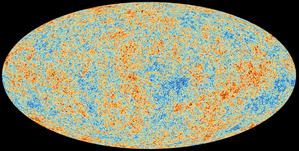Glossary term: Fond diffus cosmologique (FDC ou CMB en anglais)
Description: Le fond diffus cosmologique (FDC ou CMB en anglais) est le rayonnement électromagnétique relique datant de l'époque où l'Univers avait environ 380 000 ans et est devenu transparent à la lumière. Il fournit des informations sur la composition, la géométrie (forme), l'évolution et le développement de la structure de l'Univers. L'Univers dense primitif était constitué d'une "soupe chaude" de particules libres (protons, neutrons, électrons) et de lumière (photons). Avant que le fond diffus cosmologique ne soit libéré et mesuré, l'interaction des photons avec les électrons libres empêchait la lumière de parcourir de longues distances. L'expansion et le refroidissement de l'Univers ont permis aux électrons libres de se combiner avec les protons pour former l'hydrogène atomique, et à la lumière de voyager à travers l'Univers. L'expansion a ensuite étiré la longueur d'onde de ces photons, ce qui les rend détectables aujourd'hui dans la région des micro-ondes du spectre électromagnétique.
Related Terms:
See this term in other languages
Term and definition status: The original definition of this term in English have been approved by a research astronomer and a teacher The translation of this term and its definition is still awaiting approval
The OAE Multilingual Glossary is a project of the IAU Office of Astronomy for Education (OAE) in collaboration with the IAU Office of Astronomy Outreach (OAO). The terms and definitions were chosen, written and reviewed by a collective effort from the OAE, the OAE Centers and Nodes, the OAE National Astronomy Education Coordinators (NAECs) and other volunteers. You can find a full list of credits here. All glossary terms and their definitions are released under a Creative Commons CC BY-4.0 license and should be credited to "IAU OAE".
If you notice a factual or translation error in this glossary term or definition then please get in touch.
Related Media
Cosmic Microwave Background Radiation
Credit: ESA/Planck Collaboration credit link
License: CC-BY-SA-4.0 Creative Commons Attribution - Partage dans les Mêmes Conditions 4.0 International (CC BY-SA 4.0) icons









